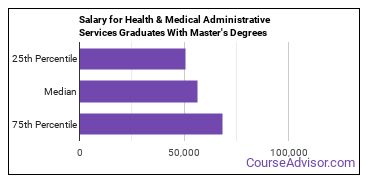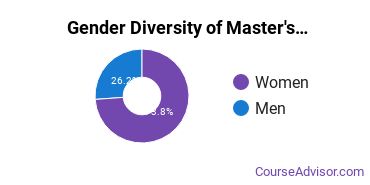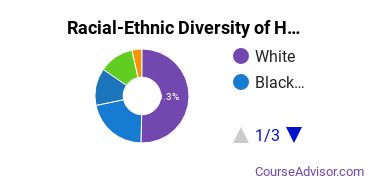Master’s Degrees in Health & Medical Administrative Services
Featured schools near , edit
Education Levels of Health & Medical Administrative Services Majors
In 2020-2021, 15,736 earned their master's degree in health and medical administrative services. This earns it the #15 spot on the list of the most popular master's degree programs in the nation.
The following table shows the number of diplomas awarded in health and medical administrative services at each degree level.
| Education Level | Number of Grads |
|---|---|
| Undergraduate Certificate | 19,645 |
| Bachelor’s Degree | 19,391 |
| Associate Degree | 16,893 |
| Basic Certificate | 16,095 |
| Master’s Degree | 15,736 |
| Graduate Certificate | 1,215 |
| Doctor’s Degree | 384 |
Earnings of Health & Medical Administrative Services Majors With Master’s Degrees
The median salary for graduates holding a master's degree in health and medical administrative services is $56,688. However, this can depend on a number of factors, such as where you live and the number of years experience you have. To get a better picture, earnings for this category of people can range from a low of $50,875 to a high of $68,205.

Student Debt
We do not have the data to estimate the median debt for this class of people.
Student Diversity
More women than men pursue their master's degree in health and medical administrative services. About 73.8% of graduates with this degree are female.
| Gender | Number of Grads |
|---|---|
| Men | 4,117 |
| Women | 11,619 |

The racial-ethnic distribution of health and medical administrative services master’s degree students is as follows:
| Race/Ethnicity | Number of Grads |
|---|---|
| Asian | 1,442 |
| Black or African American | 3,067 |
| Hispanic or Latino | 1,717 |
| White | 7,188 |
| International Students | 497 |
| Other Races/Ethnicities | 1,825 |

Most Popular Health & Medical Administrative Services Programs for Master’s Degrees
There are 425 colleges that offer a master’s degree in health and medical administrative services. Learn more about the most popular 20 below:
Western Governors University tops the list of the most popular school in the U.S. for health and medical administrative services majors who are seeking their master's degree. Roughly 147,800 attend the school each year. The average in-state tuition for full-time undergraduates is $7,162 per year, while in-state graduate students, on average, pay $7,500 per year. The health and medical administrative services program at Western Governors University awarded 1,991 master's degrees during the 2020-2021 school year. Around 25% of these students were from an underrepresented racial-ethnic group, and 74% were women.
University of Phoenix - Arizona comes in at #2 on our list of the most popular colleges offering master's degrees in health and medical administrative services. Each year, around 89,700 students seeking various degrees attend the university. The average in-state tuition for full-time undergraduates is $9,552 per year, while in-state graduate students, on average, pay $16,153 per year. During the 2020-2021 academic year, 761 people received their master's degree in health and medical administrative services from UOPX - Arizona. About 87% of this group were women, and 52% were students from an underrepresented racial-ethnic group.
Capella University comes in at #3 on our list of the most popular colleges offering master's degrees in health and medical administrative services. Roughly 38,900 attend the school each year. The average in-state tuition for full-time undergraduates is $14,148 per year, while in-state graduate students, on average, pay $14,784 per year. The health and medical administrative services program at Capella University awarded 535 master's degrees during the 2020-2021 school year. Of these students, 82% were women and 40% were members of underrepresented racial-ethnic groups.
Louisiana State University - Shreveport is the 4th most popular school in the nation for students seeking a master's degree in health and medical administrative services. Roughly 9,900 attend the school each year. The average in-state tuition for full-time undergraduates is $5,656 per year, while in-state graduate students, on average, pay $6,196 per year. During the 2020-2021 academic year, 416 people received their master's degree in health and medical administrative services from Louisiana State University - Shreveport. Around 34% of these students were from an underrepresented racial-ethnic group, and 69% were women.
Southern New Hampshire University comes in at #5 on our list of the most popular colleges offering master's degrees in health and medical administrative services. Each year, around 134,300 students seeking various degrees attend the university. The average in-state tuition for full-time undergraduates is $15,000 per year, while in-state graduate students, on average, pay $18,900 per year. During the 2020-2021 academic year, 358 people received their master's degree in health and medical administrative services from SNHU. Of these students, 82% were women and 40% were members of underrepresented racial-ethnic groups.
Colorado State University - Global Campus comes in at #6 on our list of the most popular colleges offering master's degrees in health and medical administrative services. Each year, around 12,500 students seeking various degrees attend the university. The average in-state tuition for full-time undergraduates is $8,400 per year, while in-state graduate students, on average, pay $9,000 per year. The health and medical administrative services program at Colorado State University - Global Campus awarded 343 master's degrees during the 2020-2021 school year. Of these students, 79% were women and 32% were members of underrepresented racial-ethnic groups.
Purdue University Global is the 7th most popular school in the nation for students seeking a master's degree in health and medical administrative services. Roughly 43,900 attend the school each year. The average in-state tuition for full-time undergraduates is $10,080 per year, while in-state graduate students, on average, pay $8,730 per year. For the 2020-2021 academic year, 301 master's degrees were handed out to health and medical administrative services majors at Purdue University Global. Of these students, 82% were women and 52% were members of underrepresented racial-ethnic groups.
The 8th most popular school in the country for health and medical administrative services majors who are seeking their master's degree is George Washington University. Each year, around 27,000 students seeking various degrees attend the university. The average in-state tuition for full-time undergraduates is $57,894 per year, while in-state graduate students, on average, pay $32,850 per year. For the 2020-2021 academic year, 274 master's degrees were handed out to health and medical administrative services majors at GWU. About 77% of this group were women, and 54% were students from an underrepresented racial-ethnic group.
The 9th most popular school in the country for health and medical administrative services majors who are seeking their master's degree is The University of Arizona Global Campus. Roughly 31,100 attend the school each year. The average in-state tuition for full-time undergraduates is $13,280 per year, while in-state graduate students, on average, pay $13,720 per year. For the 2020-2021 academic year, 246 master's degrees were handed out to health and medical administrative services majors at UAGC. About 85% of this group were women, and 59% were students from an underrepresented racial-ethnic group.
Grand Canyon University comes in at #10 on our list of the most popular colleges offering master's degrees in health and medical administrative services. Roughly 103,400 attend the school each year. The average in-state tuition for full-time undergraduates is $16,401 per year, while in-state graduate students, on average, pay $10,621 per year. During the 2020-2021 academic year, 243 people received their master's degree in health and medical administrative services from Grand Canyon University. Around 55% of these students were from an underrepresented racial-ethnic group, and 80% were women.
The 11th most popular school in the country for health and medical administrative services majors who are seeking their master's degree is Texas Tech University Health Sciences Center. Roughly 5,200 attend the school each year. The average in-state tuition for full-time undergraduates is $6,665 per year, while in-state graduate students, on average, pay $6,360 per year. During the 2020-2021 academic year, 222 people received their master's degree in health and medical administrative services from TTUHSC. About 69% of this group were women, and 49% were students from an underrepresented racial-ethnic group.
Walden University comes in at #12 on our list of the most popular colleges offering master's degrees in health and medical administrative services. Roughly 49,600 attend the school each year. The average in-state tuition for full-time undergraduates is $10,064 per year, while in-state graduate students, on average, pay $9,651 per year. The health and medical administrative services program at Walden University awarded 213 master's degrees during the 2020-2021 school year. About 77% of this group were women, and 54% were students from an underrepresented racial-ethnic group.
Oklahoma State University Center for Health Sciences comes in at #13 on our list of the most popular colleges offering master's degrees in health and medical administrative services. Roughly 1,200 attend the school each year. For the 2020-2021 academic year, 209 master's degrees were handed out to health and medical administrative services majors at OSU Center for Health Sciences. About 63% of this group were women, and 32% were students from an underrepresented racial-ethnic group.
Johns Hopkins University is the 14th most popular school in the nation for students seeking a master's degree in health and medical administrative services. Roughly 28,800 attend the school each year. The average in-state tuition for full-time undergraduates is $58,720 per year, while in-state graduate students, on average, pay $58,720 per year. The health and medical administrative services program at Johns Hopkins University awarded 206 master's degrees during the 2020-2021 school year. Around 36% of these students were from an underrepresented racial-ethnic group, and 71% were women.
Ohio University - Athens Campus is the 15th most popular school in the nation for students seeking a master's degree in health and medical administrative services. Roughly 25,700 attend the school each year. The average in-state tuition for full-time undergraduates is $12,840 per year, while in-state graduate students, on average, pay $9,444 per year. For the 2020-2021 academic year, 194 master's degrees were handed out to health and medical administrative services majors at OHIO Athens. Of these students, 75% were women and 20% were members of underrepresented racial-ethnic groups.
The 16th most popular school in the country for health and medical administrative services majors who are seeking their master's degree is American InterContinental University - Online. Each year, around 15,400 students seeking various degrees attend the university. The average in-state tuition for full-time undergraduates is $11,758 per year, while in-state graduate students, on average, pay $12,244 per year. During the 2020-2021 academic year, 154 people received their master's degree in health and medical administrative services from AIU Online. Of these students, 73% were women and 65% were members of underrepresented racial-ethnic groups.
University of Southern California is the 17th most popular school in the nation for students seeking a master's degree in health and medical administrative services. Roughly 46,200 attend the school each year. The average in-state tuition for full-time undergraduates is $60,446 per year, while in-state graduate students, on average, pay $60,446 per year. During the 2020-2021 academic year, 151 people received their master's degree in health and medical administrative services from USC. About 67% of this group were women, and 61% were students from an underrepresented racial-ethnic group.
University of Maryland Global Campus comes in at #18 on our list of the most popular colleges offering master's degrees in health and medical administrative services. Roughly 58,500 attend the school each year. The average in-state tuition for full-time undergraduates is $7,344 per year, while in-state graduate students, on average, pay $9,072 per year. For the 2020-2021 academic year, 149 master's degrees were handed out to health and medical administrative services majors at UMGC. Around 62% of these students were from an underrepresented racial-ethnic group, and 85% were women.
California State University - East Bay comes in at #19 on our list of the most popular colleges offering master's degrees in health and medical administrative services. Roughly 16,200 attend the school each year. The average in-state tuition for full-time undergraduates is $5,742 per year, while in-state graduate students, on average, pay $7,176 per year. During the 2020-2021 academic year, 147 people received their master's degree in health and medical administrative services from Cal State East Bay. Around 76% of these students were from an underrepresented racial-ethnic group, and 73% were women.
Colorado Technical University - Colorado Springs comes in at #20 on our list of the most popular colleges offering master's degrees in health and medical administrative services. Roughly 28,200 attend the school each year. The average in-state tuition for full-time undergraduates is $11,939 per year, while in-state graduate students, on average, pay $13,683 per year. The health and medical administrative services program at Colorado Technical University - Colorado Springs awarded 127 master's degrees during the 2020-2021 school year. About 87% of this group were women, and 40% were students from an underrepresented racial-ethnic group.
Explore Major by State
Alabama
Arkansas
Connecticut
Florida
Idaho
Iowa
Louisiana
Massachusetts
Mississippi
Nebraska
New Jersey
North Carolina
Oklahoma
Rhode Island
Tennessee
Vermont
West Virginia
Related Majors
Below are some popular majors that are similar to health and medical administrative services that offer master’s degrees.
| Major | Annual Degrees Awarded |
|---|---|
| Nursing | 51,608 |
| Public Health | 16,133 |
| Mental & Social Health Services | 14,517 |
| Allied Health Professions | 12,328 |
| Communication Sciences | 9,211 |
References
*The racial-ethnic minority student count is calculated by taking the total number of students and subtracting white students, international students, and students whose race/ethnicity was unknown. This number is then divided by the total number of students at the school to obtain the percentage of racial-ethnic minorities.
More about our data sources and methodologies.
Featured Schools
 Request Info
Request Info
|
Southern New Hampshire University You have goals. Southern New Hampshire University can help you get there. Whether you need a bachelor's degree to get into a career or want a master's degree to move up in your current career, SNHU has an online program for you. Find your degree from over 200 online programs. Learn More > |










